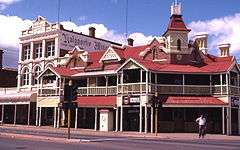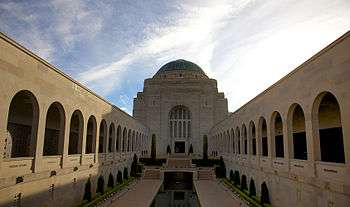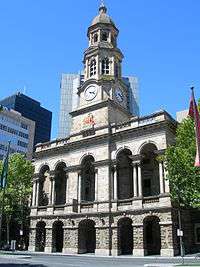Register of the National Estate
Anzac_War_Memorial3.jpg)
The Register of the National Estate was a heritage register that listed natural and cultural heritage places in Australia that was closed in 2007. It has been replaced by the Australian National Heritage List and the Commonwealth Heritage List.[1]
History
The register was initially compiled between 1976 and 2003 by the Australian Heritage Commission,[2] after which the register was maintained by the Australian Heritage Council. 13,000 places were listed.
The expression "national estate" was first used by the British architect Clough Williams-Ellis, and reached Australia in the 1970s.[3] It was incorporated into the Australian Heritage Commission Act[3] and is used to describe a collection of buildings and sites that are worthy of preservation for a variety of reasons. It covers natural environments as well as European history and Aboriginal culture.
Process of listing
Anyone could suggest that a certain site should be listed on the Register of the National Estate. A nomination form was provided and was then submitted to an expert group for evaluation. If a place was accepted for listing, the nomination is declared in the Commonwealth Gazette and newspapers. The Heritage Council eventually made a decision after the public has had time to comment and raise possible objections. The listing, if it took place, was based on an assessment of the values of the nominated place, whether "aesthetic, historic, scientific, or social significance, or other special value".[3]
A listing on the Register required that a Commonwealth Minister or authority should not take any course of action that would adversely affect the listed subjects unless there was no alternative; in the latter case, the Minister was obliged to take steps to minimise any effect on the listed subject.[3] The listing did not impose any legal obligations on private owners, companies, State governments or local governments. The Australian Heritage Council had to be consulted if any government wanted to take a course of action that might have an adverse effect on a listed subject. The Council itself could not make decisions on a proposed course of action; such decisions were made by the Federal Minister or the relevant authority contemplating the course of action.[3]
End of the register
The Register of the National Estate was frozen in February 2007. It continued until February 2012 after which it was replaced by the Australian National Heritage List for places of outstanding heritage value for Australia and the Commonwealth Heritage List for heritage places that are owned or controlled by the Commonwealth of Australia.[1][4]
Examples of listed sites
The following Sydney buildings are examples of sites listed on Register of the National Estate:[5]
- The Abbey, Annandale
- Admiralty House, Kirribilli
- Annandale Post Office, Johnston Street, Annandale
- Art Gallery of New South Wales, Art Gallery Road
- Australian Museum, College Street
- Burns Philp Building, Bridge Street
- Central railway station, Sydney
- Christchurch, Walker Street, North Sydney
- Corporation Building, Hay Street
- Customs House, Sydney, Alfred Street
- Department of Lands building, Bridge Street
- Department of Education Building, Bridge Street
- Former Gresham Hotel, Corner York and Druitt Streets
- Former Bank Building, Corner George and Bathurst Street
- General Post Office, Sydney, Martin Place
- Government House, Sydney, Bennelong Point
- Hyde Park Barracks, Sydney, Macquarie Street
- Kirribilli House, Kirribilli
- Loreto Kirribilli, Carabella Road, Kirribilli
- MLC building, North Sydney, first high-rise in the North Shore
- North Sydney Post Office, Pacific Highway, North Sydney
- Parliament House, Sydney, Macquarie Street
- Queen Victoria Building, George Street
- St Andrew's Cathedral, Sydney, George Street
- St Francis Xavier Church, Mackenzie Street, North Sydney
- St James' Church, Sydney, King Street
- St Peter's Church, Blues Point Road, North Sydney
- State Library of New South Wales, Macquarie Street
- Sydney Harbour Bridge
- Sydney Hospital, Macquarie Street
- Sydney Mint, Macquarie Street
- Sydney Opera House, Bennelong Point
- Sydney Town Hall, George Street
 St David's Cathedral, Hobart, Tasmania
St David's Cathedral, Hobart, Tasmania Exchange Hotel, Kalgoorlie, Western Australia
Exchange Hotel, Kalgoorlie, Western Australia Aboriginal paintings, Kakadu National Park, Northern Territory
Aboriginal paintings, Kakadu National Park, Northern Territory
 Adelaide Town Hall, South Australia
Adelaide Town Hall, South Australia The Rialto Building is designed by William Pitt, the 1889 is situated next to the Rialto Towers and prevented its development until the 1980s.
The Rialto Building is designed by William Pitt, the 1889 is situated next to the Rialto Towers and prevented its development until the 1980s.
 Kew Asylum (Willsmere), Melbourne, Victoria
Kew Asylum (Willsmere), Melbourne, Victoria
See also
References
External links
![]() Media related to Register of the National Estate at Wikimedia Commons
Media related to Register of the National Estate at Wikimedia Commons